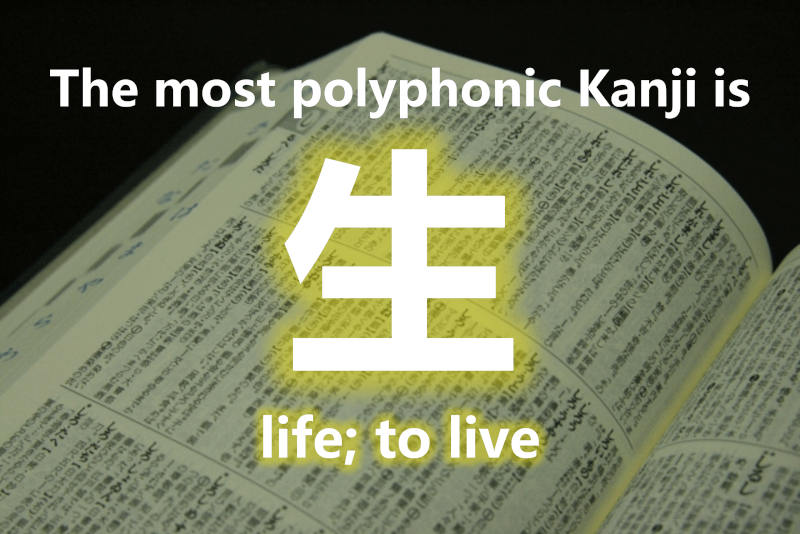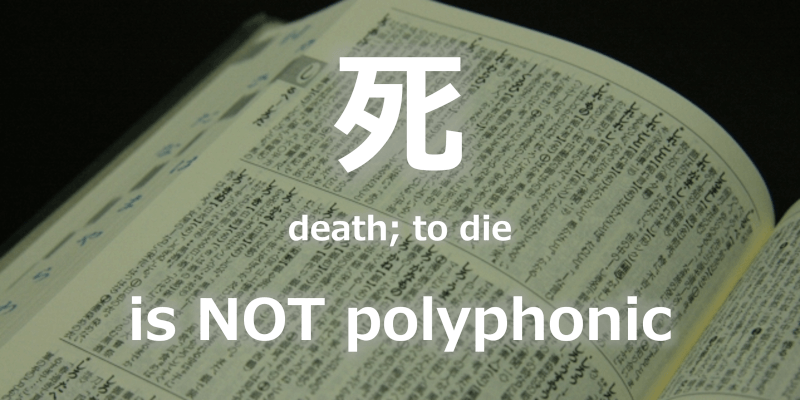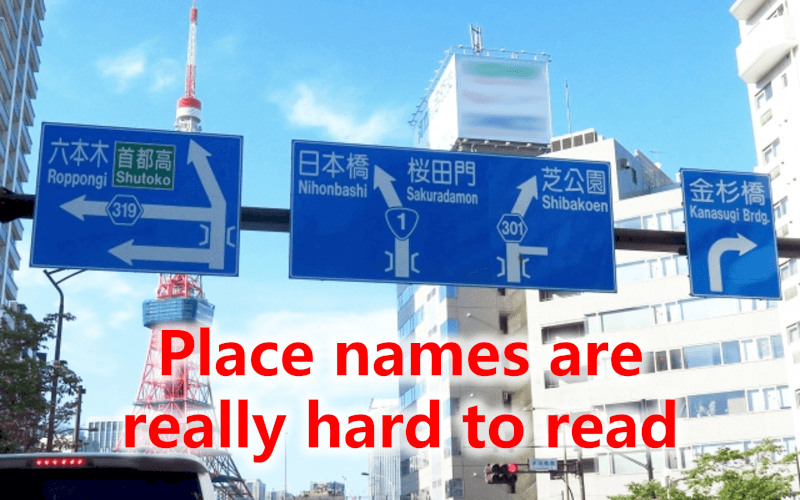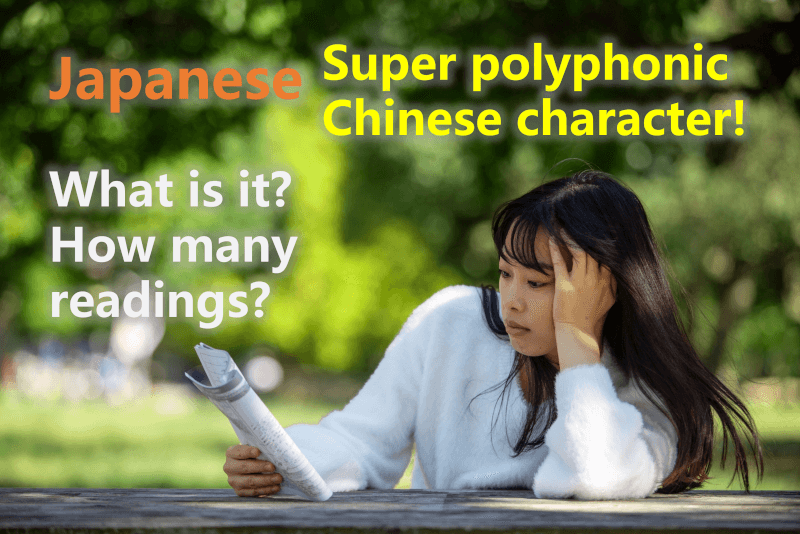Click here for the Chinese version
点击这里并查看中文版本
All the Japanese people know what the most polyphonic Chinese character in Japanese is. However, nobody knows the exact number of readings.
In Japanese, Chinese character is called "Kanji".
In Japanese, the most polyphonic Kanji is "生" (life; to live)!
How come no one knows?
Well, let me start from the brief explanation of reading Kanji.
気になる内容にすぐに移動
Japanese Kanji
Daily-use Kanji
Japanese people use roughly 3,000 Kanji characters. It sounds like a huge number, but it is still less than Chinese people. (Chinese use between 5,000 and 6,000 characters.)
The Japanese government standardized the number of daily-use Kanji to 2136. (It is called "Joyo Kanji-hyo" which is the official list of Kanji in common use.)
As for the Chinese government, the standardized numbers are as follows.
In Total: 8,105, Level-1: 3,500, Level-2: 3,000, Level-3: 1,605
As you noticed, the both numbers of Chinese characters are huge!
The most of Chinese characters are logically constructed from constituent radicals (parts), and each character has the meaning(s).
Although Chinese people use more characters, polyphonic characters are not many as Kanji.
The most of Chinese characters are not polyphonic, and around 5% of daily-use characters are polyphonic. Typical polyphonic character has 2 pronunciations or can be 3.
In Japanese, the most of Kanjis are polyphonic. Typically, it has both "音読み" (On-yomi) and "訓読み" (Kun-yomi). "音" (on) means "sound", "訓" (kun) means "meaning", and "読み" (yomi) means "reading".
On-yomi is based on the original Chinese pronunciation, and Kun-yomi is based on the original Japanese speaking.
Polyphonic Kanji
Although this data is not latest, in 1998, Dr. Yoshiharu Kojima (Department of Japanese studies, The Chinese University of Hong Kong) reported the number of polyphonic Kanji. (At the time, the official Joyo Kanji-hyo covers 1,945 characters.)
Only an On-yomi, and no Kun-yomi: 664 Kanjis
No On-yomi, and only a Kun-yomi: 36 Kanjis
This leads 700 of 1,945 are non-polyphonic, approximately 35%.
Although this data shows that 65% of Kanjis are polyphonic, this is based on dictionary definitions. It will be over 65%!
Why are there more pronunciations which are not in the dictionary?
The main reason is some of the pronunciations are based on the ancient Japanese speaking.
We often see this kind of differences in the place names, for example.
Before Chinese characters are introduced into Japan, people used to call the name of places without letters.
After Chinese characters are brought by China, Japanese people assigned the original Japanese language to each Chinese character’s meaning, and added the pronunciation(s) to the Chinese character. This is the Kun-yomi.
As the results, the numbers of Kun-yomi became more and more!
Moreover, by the Japanese accents, the changes in the pronunciations could increase the number.
Person’s name as well, and the name of country as well!
The standard name of Japan "日本" is [にっぽん][nippon]
However, [にほん][nihon] is also in common use
It is likely that Japan is only the country which has two common names in a language.
We found various Kun-yomis, but please don't worry!
The basic pronunciation of Japanese is not so difficult. All we know reading Kanji is not easy. You shouldn't be embarrassed!
What is the most polyphonic Kanji?
What is the most polyphonic Kanji?
The most polyphonic Kanji is "生" (life; to live)
We can easily image that the word related to our daily life is the most common, and speaking can be easily changed.
It is interesting that same character in Chinese language is NOT polyphonic, the pronunciation is [shēng] only.

Readings in dictionary
Let us take a look at the reading in the dictionary.
In Japanese dictionary, we can see "生" has 2 On-yomis and 12 Kun-yomis.
The 2 On-yomis came from the ancient Chinese dialects.
The others came from speaking, can be changed.
Each definition is referred from https://jisho.org/
音読み On-yomi (2)
セイ [sei]
For example,
- 生活 (セイカツ) [sei katsu]
= life; living - 生命 (セイメイ) [sei mei]
= life - 学生 (ガクセイ) [gaku sei]
= student - 先生 (センセイ) [sen sei]
= teacher - 生産 (セイサン) [sei san]
= production
ショウ(シャウ) [shou (shau)]
For example,
- 一生 (イッショウ) [isshou]
= whole life; a lifetime - 殺生 (セッショウ) [sesshou]
= killing; destruction of life - 誕生日 (タンジョウビ) [tan jou bi] (a kind of changes)
= birthday
訓読み Kun-yomi (12)
い [i]
For example,
- い・きる [i kiru] 生きる
= to live; to exist - い・かす [i kasu] 生かす
= to let live - い・ける [i keru] 生ける
= can live, making Ikebana (flower arrangement)
う [u]
For example,
- う・まれる [u mareru] 生まれる
= to be born - う・む [u mu] 生む
= to give birth
は [ha]
For example,
- は・える [ha eru] 生える
= to grow; to spring up; to sprout - は・やす [ha yasu] 生やす
= to grow; to cultivate; to wear a beard
なま [nama]
For example,
- なま・びーる [nama biru] 生ビール
= draught beer - なま・たまご [nama tamago] 生卵
= raw egg
熟语里的读法
お [o]
For example,
- お・いたち [o i tachi] 生い立ち
= one's early life; upbringing; personal history
き [ki]
For example,
- き・じょうゆ [ki jouyu] 生醤油
= pure soy sauce
なり [nari]
For example,
- なり・わい [nari wai] 生業
= occupation; calling
なまり [namari]
For example,
- なまり・ぶし [namari bushi] 生節・なまり節
= boiled and half-dried bonito
Out of official list (Joyo Kanji-hyo)
Special readings
いのち [inochi]
- = life
うぶ [ubu]
- = pure; innocent; naive; pure-hearted
な [na]
For example,
- な(す) [na su] (very rare reading)
= birth
む [mu]
For example,
- む(す) [mu su] (can see in national anthem)
= to grow
In addition to these, a lot of places use "生" in the name with the unique reading.
Although Japanese native speakers, it may not able to read except the locals!
According to a theory, the number of the pronunciation will be over 100. However, nobody knows the exact number!
What about "死" (death; to die)?
"死" is NOT polyphonic.
Although "死" has both On-yomi and Kun-yomi, both are same [し][shi].
Since ancient time, people’s desire is only "生", not "死". That's easy to figure out.
As for Chinese pronunciation, it is [sǐ] which is not far from Japanese.

We have looked through a lot of content so far. Thank you for spending your time!
I will continue to introduce more examples of place names. Or, you may be interested in the other topics below.





Readings of place names
If you are brave to keep exploring the place names, here we go!
We have 12 examples here.
相生市(兵庫県[Hyogo])
あいおい・し [Aioi-shi]
生駒市(奈良県 [Nara])
いこま・し [Ikoma-shi]
越生町(埼玉県入間郡 [Iruma-gun, Saitama])
おごせ・まち [Ogose-machi]
生野区(大阪府大阪市 [Osaka-shi, Osaka])
いくの・く [Ikuno-ku]
麻生区(神奈川県川崎市 [Kawasaki-shi, Kawasaki])
あさお・く [Asao-ku]
蒲生郡(滋賀県 [Shiga])
がもう・ぐん [Gamou-gun]
桐生市(群馬県 [Gunma])
きりゅう・し [Kiryuu-shi]
壬生町(栃木県下都賀郡 [Shimotsuga-gun, Tochigi])
みぶ・まち [Mibu-machi]
丹生郡(福井県 [Fukui])
にゅう・ぐん [Nyuu-gun]
羽生市(埼玉県 [Saitama])
はにゅう・し [Hanyuu-shi]
You may be able to guess from the last name of the figure skater.
生坂村(長野県東筑摩郡 [Higashichikuma-gun, Nagano])
いくさか・むら [Ikusaka-mura]
福生市(東京都 [Tokyo])
ふっさ・し [Fussa-shi]
I completely agree that Chinese characters are so complicated.
However, it is a kind of interesting logical puzzle.
I hope you enjoy exploring the mysterious world!








